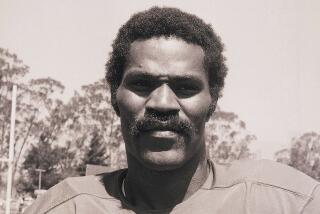George Clayton Johnson, who co-wrote ‘Logan’s Run’ and penned first ‘Star Trek’ episode, dies at 86
- Share via
Writer George Clayton Johnson, who penned early, seminal episodes of the “Twilight Zone” and “Star Trek” and helped conjure the darkly imaginative dystopia of the 1967 novel “Logan’s Run,” died Christmas Day in the San Fernando Valley. He was 86. The cause was cancer, his son, Paul B. Johnson, told the Associated Press.
Johnson, a longtime Los Angeles writer, known in his later years for his long, white hair and hippie demeanor, produced some of the most memorable science fiction stories of the 20th century.
These included writing credits on seven “Twilight Zone” episodes in the early 1960s — including “A Game of Pool,” from 1961, starring Jack Klugman and Jonathan Winters in a back-from-the-dead billiards contest, and “Nothing in the Dark,” aired in 1962, featuring a young Robert Redford as death.
Four years later, in 1966, Johnson went — literally — where no man had gone before, when he penned the first episode of “Star Trek.” That episode — his only writing credit for “Star Trek” — was titled “The Man Trap” and featured Capt. Kirk, Dr. McCoy and a crewman contending with a shape-shifting, salt-hungry vampire on the planet M-113.
Over the course of his career, the author worked on countless other projects — not all of which were in the sci-fi vein. He published the fictional Las Vegas heist story “Ocean’s 11,” which inspired the 1960 Rat Pack film of the same name — as well as a George Clooney remake more than 50 years later.
In the early 1960s, he also collaborated with science fiction novelist Ray Bradbury on the Oscar-nominated animated short film “Icarus Montgolfier Wright” — an existential tale about an astronaut based on a story by Bradbury.
But Johnson is perhaps best known for “Logan’s Run,” the 1967 novel he co-wrote with fellow sci-fi author William F. Nolan, which was turned into a movie of the same name in 1976.
The book told the story of a future world of over-consumption in which balance is maintained by exterminating all citizens at age 21. The movie changed the age to 30 and featured Michael York in the title role of Logan, a “sandman” whose job it is to track “runners” trying to escape their date with death. Logan, however, eventually comes to sympathize with a rebel faction that is sneaking off adults to a shelter in an abandoned space colony on Mars.
The movie version of Johnson and Nolan’s story was softened and made slicker by Hollywood, which stuffed it full of Late Modern interiors and ‘70s-style space caftans, and it received a drubbing from the critical press. (“Foolish concocting, indifferent acting, slow pacing and uncertain toning,” Times arts editor Charles Champlin wrote of the film in 1976.)
But the original narrative has nonetheless struck a cultural nerve over the decades. The book was written in the mid-1960s in Los Angeles, during the tumult of the uprising in Watts, among other social upheavals of the era — and in many ways it was a critique of over-consumption.
“The book was an implicit criticism of a lifestyle that destroys you and society, a lifestyle where maturity is rejected,” Nolan told the Silicon Valley weekly Metro in 2000. “You can’t live a hedonistic lifestyle and survive — you either die young or it catches up with you.”
The story may yet take hold with another generation. There is talk of a remake, spearheaded by writer-producer Simon Kinberg, in the works at Warner Bros.
Johnson was born on July 29, 1929 in Cheyenne, Wyo. He served in the Army in the late 1940s and then studied at Alabama Polytechnic Institute (now known as Auburn University), but dropped out so he could travel around the United States.
He settled in the 1950s in the Los Angeles area, where for a time he worked as a draftsman. For a few years in the late ‘50s, he was also co-owner of Cafe Frankenstein, a beatnik hangout in Laguna Beach known for its hallucinatory murals, live jazz concerts and for regularly staying open well beyond its official operating hours.
By the early 1960s, however, Johnson had settled into the life of a writer — a profession and passion he maintained until late in life. In a 2009 video posted to his YouTube channel, he happily announces: “I’m George Clayton Johnson, I make a living day-dreaming.”
In addition to his son Paul, Johnson is survived by his wife, Lola Johnson, and his daughter, Judy Olive.
Twitter @cmonstah
MORE OBITUARIES
Peggy Say, who urged release of hostage Terry Anderson, dies at 74
Louis DiGiaimo, casting director of ‘The Godfather,’ dies at 77
Alfred Gilman dies at 74; won Nobel for breakthrough research on proteins
More to Read
Start your day right
Sign up for Essential California for the L.A. Times biggest news, features and recommendations in your inbox six days a week.
You may occasionally receive promotional content from the Los Angeles Times.







